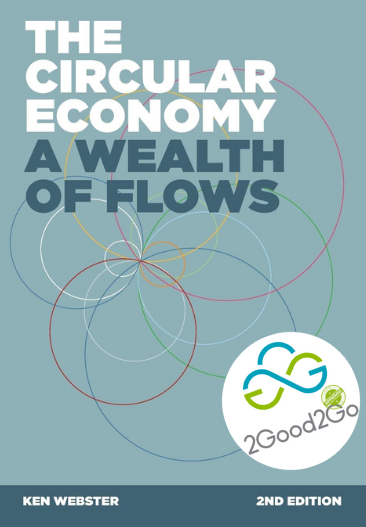Looking for a book to get informed about circular economy? If you are committed to creating a more sustainable and equitable world and want to find out more about the topic of sustainability, “The Circular Economy – A Wealth of Flows” by Ken Webster might be the right fit.
One of Webster’s greatest strengths lies in his ability to convey the urgency of embracing a circular economy model. The author adeptly highlights the inherent flaws and limitations of our current linear economic system while illustrating the vast potential for innovation and growth that lies within a circular approach. By outlining compelling case studies and success stories from diverse industries, you’ll be left with a profound sense of hope and inspiration for a more sustainable future.
Webster highlights how post-World War II companies shaped our consumption habits. They intentionally created a desire for newness, making products designed to be obsolete. It became cheaper to buy new items than to repair them, leading to a culture of disposal. Webster reminds us that “away” is a real place with environmental consequences when we discard usable objects. The author urges a shift from the wasteful linear economy, made possible by abundant resources, towards a circular economy that optimizes systems. This requires efficient take-back systems, durable products with easy disassembly and refurbishment, and selling services instead of products. Retaining ownership of goods and materials ensures future resource security, crucial in a century where resource prices are expected to rise. Embracing this mindset recognizes the value of today’s goods as tomorrow’s resources at yesterday’s prices.
The author emphasizes that the success of the linear economy came at a high cost to others and the environment, and the factors that enabled its success have shifted. In the book, he outlines four essential shifts for a circular economy:
• Implement radical resource efficiency, going beyond superficial improvements.
• Adopt biomimetic production methods to eliminate waste by designing with the concept of “everything is food.”
• Focus on providing services rather than just goods.
• Invest in natural capital and prioritize restoration.
Webster argues that the circular economy aims to maximize the utility and value of products, components, and materials continuously. This requires systemic thinking, collaborative consumption, technological advancements, and education to drive the necessary change. He is committed to addressing the intersectionality of sustainability issues, taking into consideration not only environmental aspects but also social and economic dimensions, underscoring the holistic nature of the circular economy. By emphasizing the importance of inclusivity and collaboration, the author encourages readers to think beyond their immediate sphere of influence and engage in systemic change. We need to shift our perspective from a mechanistic view of the world to one that recognizes the interconnectedness and dynamism of living systems. He calls for companies, educational institutions, and governments to adopt principles such as waste reduction, diversity for resilience, renewable energy, and systemic thinking. Understanding the interdependence of economic, social, and environmental issues is crucial to transforming our wasteful production and consumption practices. To transition a product into the circular economy, a deep understanding of its system is paramount.
Furthermore, Webster highlights the significance of collaborative consumption in driving the circular economy. To make a substantial impact, we must challenge our perception of ownership and shift towards valuing the services provided by goods rather than owning them. Collaborative consumption and take-back systems can complement each other, allowing us to access items when needed through networks while daily essentials can be owned by manufacturers. This shift encourages us to move away from viewing consumption as a means of self-expression.
The author also writes about the vital role of education in transitioning to a circular economy. The current education system falls short in promoting circular thinking. To secure the future of the circular economy, we must revamp how we educate future leaders. They need to embody qualities such as system thinking, independence, self-management, innovation, teamwork, empathy, and a commitment to lifelong learning. These transformative leaders are essential in driving the change needed to view the world as interconnected. Collaborative consumption, technological development, and education collectively enable and compel us to create the necessary change.
The book perfectly conveys the importance of embracing a circular approach; it is an opportunity to redefine our relationship with resources and foster a thriving, regenerative economy. By shifting from a linear ‘take-make-waste’ mindset to one that promotes resource efficiency, collaboration, and innovation, we can create a future where waste becomes a valuable resource and where economic growth is decoupled from environmental degradation. It is a chance to create a world where abundance flows from circularity, where sustainability and prosperity coexist harmoniously.
